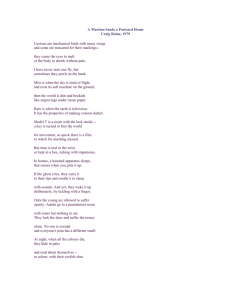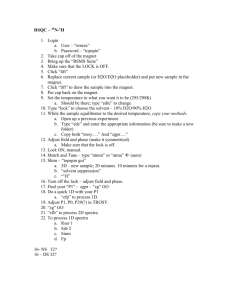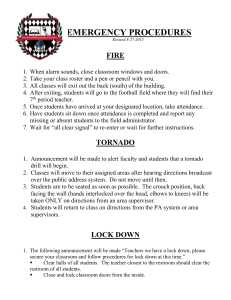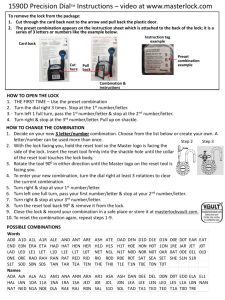pptx
advertisement
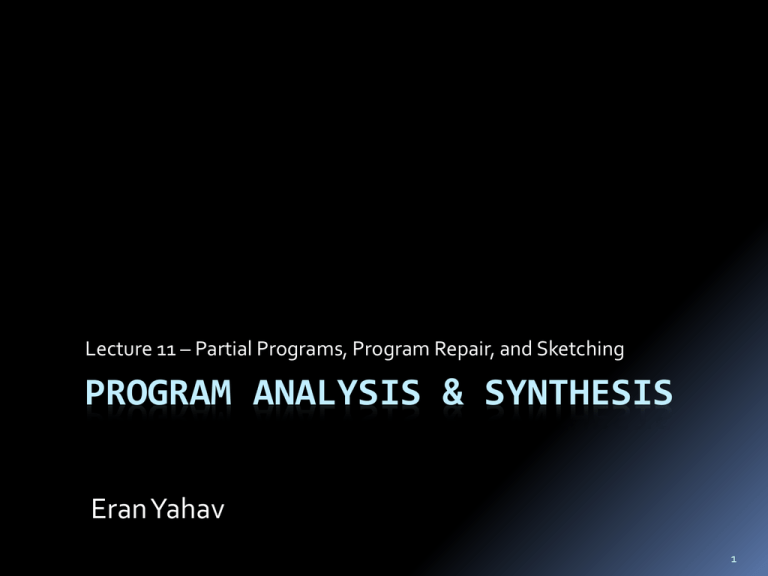
Lecture 11 – Partial Programs, Program Repair, and Sketching
PROGRAM ANALYSIS & SYNTHESIS
EranYahav
1
Previously
Synthesis from examples
SMARTEdit
String processing in spreadsheet from
examples (a little bit)
2
Today
Program Repair as a Game
angelic non-determinism in the program
Sketching
completion of partial programs using a backing
SAT solver
Acks
Program Repair slides from Barbara Jobstmann
Sketching slides cannibalized from Armando
Solar-Lezama
3
Reactive Systems
Synthesis
Systems (e.g., servers)
• Interact with environment
• Infinite duration
(non-terminating)
• Finite data (or
data abstractions)
• Control-oriented
Verification
Specifications
• Set of good behaviors
(a language)
• Temporal logic
(including safety
and liveness)
Analysis
data
time
[Z. Manna and A. Pnueli. The Temporal Logic of Reactive and Concurrent Systems., 1992]
[N. Halbwachs. Synchronous Programming of Reactive Systems. 1993]
4
How to verify a Reactive System?
Core algorithm for linear-time temporal logic:
1. Source code ➝auto/manual transition system (FSM)
2. Specification ➝auto/manual monitor violations
3. Check if model has a violating trace
product of trans. system and monitor
check for exists of a trace in product (emptiness)
L(Program)
L(Program)
L(Program
L(Specification)
L( Specification) =
Specification) =
5
Source Code
1:
2:
3:
4:
5:
6:
7:
unsigned int got_lock = 0;
...
while(*) {
...
if (*) {
lock();
got_lock++;
}
...
if (got_lock != 0) {
unlock();
}
got_lock--;
...
}
lock()
lock:
{LOCK:=1;}
unlock()
unlock: {LOCK:=0;}
6
Step 1: Transition System
int[0,1,2] got_lock = 0;
...
1: while(*) {
...
2:
if (*) {
3:
lock();
lock:
{LOCK:=1;}
4:
got_lock++;
}
...
5:
if (got_lock != 0) {
6:
unlock();
unlock: {LOCK:=0;}
}
7:
got_lock--;
...
}
Trans. system variables: line (l), got_lock (gl)
l=1, gl=0
l=1, gl=1
l=1, gl=2
l=2, gl=0
....
l=2, gl=2
l=3, gl=0
l=3, gl=2
l=lock,gl=0
l=lock,gl=2
l=4, gl=0
l=4, gl=2
l=5, gl=0
l=7, gl=0
l=5, gl=1
l=5, gl=2
l=6, gl=1
l=6, gl=2
l=unlock,gl=1
l=unlock,gl=2
l=7, gl=1
l=7, gl=2
8:
l=8, gl=0
....
....
7
Specification
P1: do not acquire a lock twice
P2: do not call unlock without holding the lock
P1: always( line=lock implies next(line!=lock w-Until line=unlock))
P2: ( line!=unlock w-until line=lock )) and
always( line=unlock implies
next( line!=unlock w-until line=lock ))
8
Linear-Time Temporal Logic
[Pnueli77]
Syntax:
Atomic propositions,
e.g., line=1, line!=1, got_lock=0
Boolean operators: not, and, or, implies,...
Temporal operators:
next (ϕ)
ϕ1 until ϕ2
... ϕ holds in the next step
... ϕ1 holds until at some point ϕ2 holds
Used in industrial spec languages PSL/SVA
Can express many interesting properties, e.g.,
mutual exclusion, deadlock freedom, termination
9
Linear-Time Temporal Logic
Semantics
defined with respect to infinite traces
in each step atomic propositions holds or not
E.g., line=1, got_lock≤1
line=1
line=1 got_lock≤1
.....
Given a finite set of atomic proposition AP,
a trace (or word) w over AP is an infinite sequence
of truth assignments to AP, i.e., w (2 AP ) .
10
Linear-Time Temporal Logic
Semantics
next (ϕ)... ϕ holds in the next step
ϕ
.....
ϕ1 until ϕ2... ϕ1 holds until at some point ϕ2 holds
ϕ1
ϕ1
ϕ1
ϕ1
.....
ϕ2
.....
System S satisfies/models ϕ, if all its
behaviors satisfy ϕ
11
How to verify a Reactive System?
Core algorithm for linear-time temporal logic:
1. Source code ➝auto/manual transition system (FSM)
2. Specification ➝auto/manual monitor violations
3. Check if model has a violating trace
product of trans. system and monitor
check for exists of a trace in product (emptiness)
12
Step 2: Monitor for Violations
P1: always( line=lock implies
next( line!=lock w-until line=unlock ))
= not eventually( line=lock and
next( line!=unlock until line=lock ))
line!=unlock
1
line=lock
s1: non-deterministic choice
2
line=lock
3
s2: no edge with line=unlock
Automaton accepts trace/behavior if a green state is visited infinitely often (Büchi )
Why do we track bad and not good behaviors?
L(S) ⊆L(ϕ): forall w: w ∈ L(S) ➝ w ∈ L(ϕ)
¬ exists w: w ∈ L(S) ∧ w ∈ L(¬ϕ)
13
Step 3: Product
l=1, gl=0
l=1, gl=1
l=1, gl=2
l=2, gl=0
....
l=2, gl=2
l=3, gl=0
l=3, gl=2
l=lock,gl=0
l=lock,gl=2
l=4, gl=0
l=4, gl=2
l=5, gl=0
l=7, gl=0
l=5, gl=1
l=5, gl=2
l=6, gl=1
l=6, gl=2
l=unlock,gl=1
l=unlock,gl=2
l=7, gl=1
l=7, gl=2
line!=unlock
1
l=8, gl=0
....
line=loc
k
line=lock
2
3
....
14
Step 3: Product
1
l=1, gl=0
1
l=1, gl=1
1
l=1, gl=2
1
l=2, gl=0
1
....
1
l=2, gl=2
1
l=3, gl=0
1
l=3, gl=2
1
l=lock,gl=0
1
l=lock,gl=2
1
l=4,
gl=0
1
l=4, gl=2
1
1
l=4,
gl=0
l=5, gl=0
l=7, gl=0
2
1 l=5, gl=1
l=5, gl=1
2
1
l=5, gl=2
1 l=6, gl=1
l=6, gl=1
2
1
1 unlock,1
unlock,1
2
1
l=6, gl=2
l=unlock,gl=
2
1 l=7, gl=1
1
l=7, gl=2
line!=unlock
1
1
l=8, gl=0
1
....
1
line=loc
k
line=lock
2
3
....
15
Step 3: Product
1
l=1, gl=0
1
l=1, gl=1
1
l=1, gl=2
l=1, gl=2
2
1
l=2, gl=0
1
....
1
l=2, gl=2
l=2, gl=2
2
1
l=3, gl=0
1
l=3, gl=2
l=3, gl=2
2
1
l=lock,gl=0
1
l=lock,gl=2
l=lock,gl=2
2
1
l=4,
gl=0
1
l=4,
gl=2
l=4, gl=2
3
1 l=5, gl=0
1 l=7, gl=0
l=4,
gl=0
2
l=5, gl=0
2
l=7, gl=0
2
l=4,
gl=2
1 l=5, gl=1
l=5, gl=1
2
1
l=5, gl=2
1 l=6, gl=1
l=6, gl=1
2
1
1 unlock,1
unlock,1
2
1
l=6, gl=2
l=unlock,gl=
2
1 l=7, gl=1
1
2
l=7, gl=2
line!=unlock
1
1
l=8, gl=0
1
....
1
line=loc
k
line=lock
2
3
....
Recall, we want to show a violation:
16
Step 3: Product
1
l=1, gl=0
1
l=1, gl=1
1
l=1, gl=2
l=1, gl=2
2
1
l=2, gl=0
1
....
1
l=2, gl=2
l=2, gl=2
2
1
l=3, gl=0
1
l=3, gl=2
l=3, gl=2
2
1
l=lock,gl=0
1
l=lock,gl=2
l=lock,gl=2
2
1
l=4,
gl=0
1
l=4,
gl=2
l=4, gl=2
3
1 l=5, gl=0
1 l=7, gl=0
l=4,
gl=0
2
l=5, gl=0
2
l=7, gl=0
2
l=4,
gl=2
1 l=5, gl=1
l=5, gl=1
2
1
l=5, gl=2
1 l=6, gl=1
l=6, gl=1
2
1
1 unlock,1
unlock,1
2
1
l=6, gl=2
l=unlock,gl=
2
1 l=7, gl=1
1
2
l=7, gl=2
line!=unlock
1
1
l=8, gl=0
1
....
1
line=loc
k
line=lock
2
3
....
Recall, we want to show a violation:
non-determinism in transition system and in monitor pull in the same direction
(both can be used to violate property)
17
Source Code
int[0,1,2] got_lock = 0;
...
1: while(*) {
...
2:
if (*) {
3:
lock();
lock:
{LOCK:=1;}
4:
got_lock++;
}
...
5:
if (got_lock != 0) {
6:
unlock();
unlock: {LOCK:=0;}
}
7:
got_lock--;
...
}
8:
line = 1
line = 2
line = 5
line = 7
line = 1
line = 2
line = 3
line = lock
line = 4
line = 5
line = 7
line = 1
line = 2
line = 3
line = lock
18
How to verify a Reactive System?
Core algorithm for linear-time temporal logic:
1. Source code ➝auto/manual transition system (FSM)
2. Specification ➝auto/manual monitor violations
3. Check if model has a violating trace
product of trans. system and monitor
check for exists of a trace in product (emptiness)
But how to repair it?
19
How to repair a Reactive System?
1. Add freedom (choice for the system, allowed ways
to modify system)
2. Source code ➝a/m transition system (game)
3. Specification ➝a/m monitor acceptance
4. Check if we can find system choices s.t. model is
accepted by monitor
product of trans. system and monitor
search for winning strategy in game
20
Step 1: Freedom
int[0,1,2] got_lock = 0;
int[0,1,2] freedom;
...
1: while(*) {
...
2:
if (*) {
3:
lock();
lock:
{LOCK:=1;}
4:
got_lock:=freedom;
}
...
5:
if (got_lock != 0) {
6:
unlock();
unlock: {LOCK:=0;}
}
7:
got_lock:=freedom;
...
}
8:
(We can also extend to fault localization)
21
Step 2: Game
Trans. system variables: line (l), got_lock (gl)
int[0,1,2] got_lock = 0;
int[0,1,2] freedom;
...
l=1, gl=0
l=1, gl=1
l=1, gl=2
1: while(*) {
l=2, gl=0
....
l=2, gl=2
...
2:
if (*) {
l=3, gl=0
l=3, gl=2
3:
lock();
l=lock,gl=2
l=lock,gl=0
lock:
{LOCK:=1;}
4:
got_lock:=freedom;
f=2
f=0
l=4, gl=2
l=4, gl=0
}
f=0
f=2
f=1
...
l=5, gl=0
l=5, gl=1
l=5, gl=2
5:
if (got_lock != 0) {
6:
unlock();
l=6, gl=1
l=6, gl=2
unlock: {LOCK:=0;}
l=unlock,gl=
l=unlock,gl=
f=0
f=1
}
1
2
7:
got_lock:=freedom;
l=7, gl=0
l=7, gl=1
l=7, gl=2
...
f=2
}
8:
l=8, gl=0
....
....
22
Step 2: Game
int[0,1,2] got_lock = 0;
Trans. system variables: line (l), got_lock (gl)
int[0,1,2] freedom;
...
l=1, gl=0
l=1, gl=1
l=1, gl=2
1: while(*) {
l=2, gl=0
....
l=2, gl=2
...
2:
if (*) {
l=3, gl=0
l=3, gl=2
3:
lock();
l=lock,gl=2
l=lock,gl=0
lock:
{LOCK:=1;}
4:
got_lock:=freedom;
f=2
f=0
l=4, gl=2
l=4, gl=0
}
f=0
f=2
f=1
...
l=5, gl=0
l=5, gl=1
l=5, gl=2
5:
if (got_lock != 0) {
6:
unlock();
l=6, gl=1
l=6, gl=2
unlock: {LOCK:=0;}
f=0
f=1
l=unlock,gl=1
l=unlock,gl=2
}
7:
got_lock:=freedom;
l=7, gl=0
l=7, gl=1
l=7, gl=2
...
f=2
}
8:
l=8, gl=0
....
Two types of non-determinism!
....
23
Step 2: Game
int[0,1,2] got_lock = 0;
Trans. system variables: line (l), got_lock (gl)
int[0,1,2] freedom;
...
l=1, gl=0
l=1, gl=1
l=1, gl=2
1: while(*) {
l=2, gl=0
....
l=2, gl=2
...
2:
if (*) {
l=3, gl=0
l=3, gl=2
3:
lock();
l=lock, gl=0
l=lock, gl=2
lock:
{LOCK:=1;}
4:
got_lock:=freedom;
f=2
f=0
l=4, gl=2
l=4, gl=0
}
f=0
f=2
f=1
...
l=5, gl=0
l=5, gl=1
5:
if (got_lock != 0) {
l=5, gl=2
l=6,
gl=1
6:
unlock();
l=6, gl=2
l=unlock,
gl=1
unlock: {LOCK:=0;}
l=unlock, gl=2
f=0
f=1
}
7:
got_lock:=freedom;
l=7, gl=0
l=7, gl=1
l=7, gl=2
...
f=2
}
8:
l=8, gl=0
....
Two types of non-determinism!
....
24
Step 3: Monitor for Acceptance
P1: always( line=lock implies
next( line!=lock w-until line=unlock ))
line!=lock
line=lock
line=unlock
line!=lock &
line!=unlock
line=lock
Since game has two types of non-determinism, we need to be careful
with non-determinism in monitor.
25
Problem with Nondeterminism
Coffee machine is correct if there is no water
or if button is pressed machine serves coffee:
eventually always(not water) or
always(pressed implies eventually coffee)
and
always(not water implies not coffee)
w=0
p=1 and
(w=1 or c=0)
w=1 or c=0
c=0 or w=1
O
K
O
K
p=0 and
w=1 or c=0
c=1 and w=1
(Coffee machine wins if it visits a green state infinitely often)
26
Step 3: Det. Monitor for Acceptance
P1: always( line=lock implies
next( line!=lock w-until line=unlock ))
line!=lock
line=lock
1
line!=lock &
line!=unlock
2
line=unlock
3
line=lock
Classical approach: make it deterministic
(more powerful acceptance required)
27
Step 3: Product
TS for got_lock in {0,1}
l=1, gl=0
l=1, gl=1
l=2, gl=0
l=1, gl=2
l=3, gl=0
l=lock, gl=0
l=3, gl=0
l=lock, gl=0
l=4, gl=0
l=4, gl=0
0
0
1
l=5, gl=0
0
Deterministic automaton
l!=lock
1
2
3
1
l=unlock
l=5, gl=1
l=6, gl=1
l=unlock, gl=1
1
l!=lock &
l!=unlock
l=lock
0
l=lock
1
l=7, gl=0
l=7, gl=1
l=8, gl=0
....
28
Step 3: Produce
l=1, gl=0 1
l=1, gl=1 1
l=1, gl=0 2
l=1, gl=1 2
l=2, gl=0 1
l=2, gl=1 1
l=2, gl=0 2
l=2, gl=1 2
l=3, gl=0 1
l=lock,
gl=0
l=3, gl=0 1
l=lock,
gl=0
l=3, gl=0 2
l=lock,
gl=0
l=3, gl=0 2
l=lock,
gl=0
l=4, gl=0 1
l=4, gl=1 1
l=4, gl=0 2
l=4, gl=1 2
0
0
1
1
0
0
1
1
l=5, gl=1 1
l=6, gl=1
l=unlock,
gl=1
l=5, gl=0 2
l=5, gl=1 2
l=6, gl=1
l=unlock,
gl=1
l=7, gl=0 1
l=7, gl=1 1
l=7, gl=0 2
l=7, gl=1 2
l=8, gl=0 1
l=8, gl=1 1
l=8, gl=0 2
l=8, gl=1 2
l=5, gl=0 1
0
1
0
l!=lock
l=4, gl=.. 3
l!=lock &
l!=unlock
l=lock
2
1
l=unlock
3
l=lock
29
Step 4: Winning States
l=1, gl=0 1
l=1, gl=1 1
l=1, gl=0 2
l=1, gl=1 2
l=2, gl=0 1
l=2, gl=1 1
l=2, gl=0 2
l=2, gl=1 2
l=3, gl=0 1
l=lock,
gl=0
l=3, gl=0 1
l=lock,
gl=0
l=3, gl=0 2
l=lock,
gl=0
l=3, gl=0 2
l=lock,
gl=0
l=4, gl=0 1
l=4, gl=1 1
l=4, gl=0 2
l=4, gl=1 2
0
0
1
1
0
0
1
1
l=5, gl=1 1
l=6, gl=1
l=unlock,
gl=1
l=5, gl=0 2
l=5, gl=1 2
l=6, gl=1
l=unlock,
gl=1
l=7, gl=0 1
l=7, gl=1 1
l=7, gl=0 2
l=7, gl=1 2
l=8, gl=0 1
l=8, gl=1 1
l=8, gl=0 2
l=8, gl=1 2
l=5, gl=0 1
0
1
0
l!=lock
l=4, gl=.. 3
l!=lock &
l!=unlock
l=lock
2
1
l=unlock
3
l=lock
30
Step 4: Winning States
l=1, gl=0 1
l=1, gl=1 1
l=1, gl=0 2
l=1, gl=1 2
l=2, gl=0 1
l=2, gl=1 1
l=2, gl=0 2
l=2, gl=1 2
l=3, gl=0 1
l=lock,
gl=0
l=3, gl=0 1
l=lock,
gl=0
l=3, gl=0 2
l=lock,
gl=0
l=3, gl=0 2
l=lock,
gl=0
l=4, gl=0 1
l=4, gl=1 1
l=4, gl=0 2
l=4, gl=1 2
0
0
1
1
0
0
1
1
l=5, gl=1 1
l=6, gl=1
l=unlock,
gl=1
l=5, gl=0 2
l=5, gl=1 2
l=6, gl=1
l=unlock,
gl=1
l=7, gl=0 1
l=7, gl=1 1
l=7, gl=0 2
l=7, gl=1 2
l=8, gl=0 1
l=8, gl=1 1
l=8, gl=0 2
l=8, gl=1 2
l=5, gl=0 1
0
1
0
l!=lock
l=4, gl=.. 3
l!=lock &
l!=unlock
l=lock
2
1
l=unlock
3
l=lock
31
Step 4: Winning States
l=1, gl=0 1
l=1, gl=1 1
l=1, gl=0 2
l=1, gl=1 2
l=2, gl=0 1
l=2, gl=1 1
l=2, gl=0 2
l=2, gl=1 2
l=3, gl=0 1
l=lock,
gl=0
l=3, gl=0 1
l=lock,
gl=0
l=3, gl=0 2
l=lock,
gl=0
l=3, gl=0 2
l=lock,
gl=0
l=4, gl=0 1
l=4, gl=1 1
l=4, gl=0 2
l=4, gl=1 2
0
0
1
1
0
0
1
1
l=5, gl=1 1
l=6, gl=1
l=unlock,
gl=1
l=5, gl=0 2
l=5, gl=1 2
l=6, gl=1
l=unlock,
gl=1
l=7, gl=0 1
l=7, gl=1 1
l=7, gl=0 2
l=7, gl=1 2
l=8, gl=0 1
l=8, gl=1 1
l=8, gl=0 2
l=8, gl=1 2
l=5, gl=0 1
0
1
0
l!=lock
l=4, gl=.. 3
l!=lock &
l!=unlock
l=lock
2
1
l=unlock
3
l=lock
32
Step 4: Winning States
l=1, gl=0 1
l=1, gl=1 1
l=2, gl=0 1
l=2, gl=1 1
l=3, gl=0 1
l=lock,
gl=0
l=3, gl=0 1
l=lock,
gl=0
l=4, gl=0 1
l=4, gl=1 1
0
0
1
l=5, gl=0 1
0
1
0
1
l=5, gl=1 1
l=6, gl=1
l=unlock,
gl=1
l=7, gl=0 1
l=7, gl=1 1
l=8, gl=0 1
l=8, gl=1 1
l=4, gl=0 2
l=4, gl=1 2
1
1
l=5, gl=1 2
l=6, gl=1
l=unlock,
gl=1
33
Step 4: Winning Strategy
l=1, gl=0 1
l=1, gl=1 1
l=2, gl=0 1
l=2, gl=1 1
l=3, gl=0 1
l=lock,
gl=0
l=3, gl=0 1
l=lock,
gl=0
l=4, gl=0 1
l=4, gl=1 1
0
1
l=5, gl=0 1
0
0
l=5, gl=1 1
l=6, gl=1
l=unlock,
gl=1
l=7, gl=0 1
l=7, gl=1 1
l=8, gl=0 1
l=8, gl=1 1
In general: strategy is function of program and monitor state
l=4, gl=0 2
l=4, gl=1 2
1
1
l=5, gl=1 2
l=6, gl=1
l=unlock,
gl=1
Strategy to Repair:
if (l=4 & gl=0 & s=1) freedom:=0
if (l=4 & gl=1 & s=1) freedom:=1
if (l=4 & gl=0 & s=0) freedom:=1
if (l=7 & gl=0 & s=1) freedom:=0
if (l=7 & gl=1 & s=1) freedom:=0
..
freedom := f(l,gl,s)
if (line=4)
freedom := (gl=1) | (s=2)
if (line=7)
freedom := 0
What we actually do: merge states before picking the strategy
34
Step 4: Winning Strategy
l=1, gl=0 1
l=1, gl=1 1
l=1, gl=0
l=1, gl=1
l=2, gl=0 1
l=2, gl=1 1
l=2, gl=0
l=2, gl=1
l=3, gl=0 1
l=lock,
gl=0
l=3, gl=0 1
l=lock,
gl=0
l=3, gl=0
l=lock,
gl=0
l=3, gl=0
l=lock,
gl=0
l=4, gl=0 1
l=4, gl=1 1
l=4, gl=0
l=4, gl=1
0
0
1
l=5, gl=0 1
0
1
1
l=5, gl=1 1
l=6, gl=1
l=unlock,
gl=1
0
l=4, gl=0 2
l=4, gl=1 2
1
1
1
l=5, gl=1 2
l=6, gl=1
l=unlock,
gl=1
l=5, gl=0
0
1
1
l=5, gl=1
l=6, gl=1
l=unlock,
gl=1
0
l=7, gl=0 1
l=7, gl=1 1
l=7, gl=0
l=7, gl=1
l=8, gl=0 1
l=8, gl=1 1
l=8, gl=0
l=8, gl=1
1
35
Step 4: Winning Strategy
(line=4): freedom= 1
l=1, gl=0
l=1, gl=1
l=2, gl=0
l=2, gl=1
l=3, gl=0
l=lock,
gl=0
l=3, gl=0
l=lock,
gl=0
l=4, gl=0
l=4, gl=1
1
l=5, gl=0
0
(line=7): freedom= 0
0
1
l=5, gl=1
l=6, gl=1
l=unlock,
gl=1
l=7, gl=0
l=7, gl=1
l=8, gl=0
l=8, gl=1
36
Repaired Program
1:
2:
3:
4:
5:
6:
7:
unsigned int got_lock = 0;
lock() {
...
lock: LOCK:=1;}
while(*) {
unlock(){
...
unlock: LOCK:=0;}
if (*) {
lock();
Specification
got_lock = 1;
P1: do not acquire a lock twice
}
P2: do not call unlock without holding the lock
...
if (got_lock != 0){
P1: always( line=lock implies
next( line!=lock w-until line=unlock ))
unlock();
P2: ( line!=unlock w-until line=lock )) and
}
always( line=unlock implies
got_lock = 0;
next( line!=unlock w-until line=lock ))
...
}
(slide adapted with permission from Barbara Jobstmann)
37
Recap: How to Repair a Reactive System?
1. Add freedom
choice for the system, space of permitted modifications to
the system
2. Source code ➝ transition system (game)
non-determinism in the program (demonic)
non-determinism in permitted modification (angelic)
3. Specification ➝ monitor acceptance
4. Check if we can find system choices s.t. model is
accepted by monitor
product of trans. system and monitor
search for winning strategy in game
38
Program Repair
Program
Game
Finite-state
program
Game TS:
program with
freedom
Solve game
Monitor
Specification
Monitor TS:
Winning
condition
(Simple)
Strategy
Correct
Program
with Bloem, Griesmayer, Staber in CAV 2005, CHARME 2005 (+ext to fault localization)
Classical Controller Synthesis
Game
FSM
+ freedom
+ monitor
Initially defined for invariants
Game TS +
winning cond.
Solve game
(Simple)
Strategy
Correct
Program
Ramadge, Wonham 87, Book by Cassandras, Lafortune 99/07
Synthesis from Temporal Logics
Game
Solve game
Monitor +
interface
definition
Specification
Monitor TS:
Winning
condition
(Simple)
Strategy
Correct
Program
Church (1962), Büchi/Landweber (1969, games), Rabin (1972, trees), Pnueli/Rosner (1989, LTL)
Program Synthesis
Program
Game
FSM
+ freedom
Game TS
Solve game
Monitor
Specification
Monitor TS:
Winning
condition
(Simple)
Strategy
Correct
Program
Modern Controller Synthesis, see overview papers by Walukiewicz et al., Rutten & Girault, ...
Issues?
Program
Game
How to
abstract?
FSM
+ freedom
Size?
How to
solve
efficiently?
Game TS
Solve game
How to
construct
efficiently?
Monitor
Monitor TS:
Winning
condition
How
expressive?
Size?
Specification
How to
specify?
How to map
Related research areas:
back?
PL, AV, Control Theory,
Game and Automata Theory
(Simple)
Strategy
Correct
Program
How to pick
a strategy?
Issues with Monitor for LTL
Determinization construction (Safra’s)
2EXP worst case complexity
LTL is very succinct
How to
construct
efficiently?
Monitor
Monitor TS:
Winning
condition
How
expressive?
Size?
Some Solutions
Concentrate on subsets (different types of games)
Ramadge, Wonham (Proc IEEE‘89)
Asarin, Maler, Pnueli, Sifakis (SSC’98)
Alur, La Torre (LICS'01)
Alur, Madhusudan, Nam (BMC'03, STTT'05)
Wallmeier, Hütter, Thomas (CIAA'03)
Harding, Ryan, Schobbens (TACAS'05)
Jobstmann, Bloem (CAV’05)
Piterman, Pnueli, Sa'ar (VMCAI'06)
(base of our work on synthesizing AMBA)
Safety, Reachability
Büchi, co-Büchi
Det. generators for several subsets
Safety+ using SAT, QBF, and BDDs
Optimize or avoid determinzation construction
Request-Response
Work with nondet. automaton
Identified syntactic subset
Generalized Reactivity-1 (GR-1)
Implemented Safra
Althoff, Thomas, Wallmeier (CIAA'05,TCS'06)
Improved Safra, Good-for-game
Piterman, Henzinger (CSL'06)
Kupferman, Vardi (FOCS'05)
Bounded Synthesis
Kupferman, Piterman, Vardi (CAV'06)
(using co-Büchi)
Schewe, Finkbeiner (ATVA'07), Filiot, Jin, Raskin (CAV'09)
Symbolic representation (e.g., using BDDs)
Next
More partial programs…
this time with Sketching
46
What is sketching?
A program synthesis system
generates small fragments of code
checks their validity against a specification
A programming aid
help you write tricky programs
cleverness and insight come from you
sorry, no programming robots
computer helps with low-level reasoning
The sketching experience
sketch
implementation
(completed sketch)
Sketch language basics
Sketches are programs with holes
write what you know
use holes for the rest
2 semantic issues
specifications
How does SKETCH know what program you actually
want?
holes
Constrain the set of solutions the synthesizer may
consider
Specifications
Specifications constrain program behavior
assertions
assert x > y;
function equivalence
blockedMatMul(Mat a, Mat b) implements matMul
Is this enough?
Holes
Holes are placeholders for the synthesizer
synthesizer replaces hole with concrete code fragment
fragment must come from a set defined by the user
Integer hole
Define sets of integer constants
Example: Hello World of Sketching
spec:
int foo (int x)
{
return x + x;
}
sketch:
int bar (int x) implements foo
{
return x * ??;
}
Integer Hole
Integer Holes Sets of Expressions
Example: Find least significant zero bit
0010 0101 0000 0010
int W = 32;
bit[W] isolate0 (bit[W] x) { // W: word size
bit[W] ret = 0;
for (int i = 0; i < W; i++)
if (!x[i]) { ret[i] = 1; return ret; }
}
Trick:
Adding 1 to a string of ones turns the next zero to a 1
i.e. 000111 + 1 = 001000
!(x + ??) & (x + ??)
!(x + 1) & (x + 0)
!(x + 1) & (x + 0xFFFF)
!(x + 0) & (x + 1)
!(x + 0xFFFF) & (x + 1)
Integer Holes Sets of Expressions
Example: Least Significant Zero Bit
0010 0101 0000 0010
int W = 32;
bit[W] isolate0 (bit[W] x) { // W: word size
bit[W] ret = 0;
for (int i = 0; i < W; i++)
if (!x[i]) { ret[i] = 1; return ret; }
}
bit[W] isolateSk (bit[W] x) implements isolate0 {
return !(x + ??) & (x + ??) ;
}
Integer Holes Sets of Expressions
Least Significant One Bit
0010 0100 0000 0100
int W = 32;
bit[W] isolate0 (bit[W] x) { // W: word size
bit[W] ret = 0;
for (int i = 0; i < W; i++)
if (x[i]) { ret[i] = 1; return ret; }
}
Will the same trick work?
try it out
Integer Holes Sets of Expressions
Expressions with ?? == sets of expressions
linear expressions
polynomials
sets of variables
x*?? + y*??
x*x*?? + x*?? + ??
?? ? x : y
Semantically powerful but syntactically clunky
Regular Expressions are a more convenient way of
defining sets
Regular Expression Generators
{| RegExp |}
RegExp supports choice ‘|’ and optional ‘?’
can be used arbitrarily within an expression
to select operands {| (x | y | z) + 1 |}
to select operators {| x (+ | -) y |}
to select fields
{| n(.prev | .next)? |}
to select arguments {| foo( x | y, z) |}
Set must respect the type system
all expressions in the set must type-check
all must be of the same type
Least Significant One revisited
How did I know the solution would take the form
!(x + ??) & (x + ??) .
What if all you know is that the solution involves x, +, & and !.
bit[W] tmp=0;
{| x | tmp |} = {| (!)?((x | tmp) (& | +) (x | tmp | ??)) |};
{| x | tmp |} = {| (!)?((x | tmp) (& | +) (x | tmp | ??)) |};
return tmp;
This is now a set of statements
(and a really big one too)
Sets of statements
Statements with holes = sets of statements
Higher level constructs for Statements too
repeat
bit[W] tmp=0;
repeat(3){
{| x | tmp |} = {| (!)?((x | tmp) (& | +) (x | tmp | ??)) |};
}
return tmp;
repeat
Avoid copying and pasting
repeat(n){ s}
s;s;…s;
n
each of the n copies may resolve to a distinct stmt
n can be a hole too.
bit[W] tmp=0;
repeat(??){
{| x | tmp |} = {| (!)?((x | tmp) (& | +) (x | tmp | ??)) |};
}
return tmp;
Keep in mind:
the synthesizer won’t try to minimize n
use --unrollamnt to set the maximum value of n
Example: logcount
int pop (bit[W] x)
{
int count = 0;
for (int i = 0; i < W; i++) {
if (x[i]) count++;
}
return count;
}
1 0 0 1 1 1 1 0
011 0 010 1 101 1 011 0
01
01
10
01
0010
0011
01001110
01
0010 01
00000101
0010
0011
00000101
00000101
Procedures and Sets of Procedures
2 types of procedures
standard procedures
represents a single procedure
all call sites resolve to the same procedure
identified by the keyword static
generators
represents a set of procedures
each call site resolves to a different procedure in the
set
default in the current implementation
Example
int rec(int x, int y, int z){
int t = ??;
if(t == 0){return x;}
if(t == 1){return y;}
int spec( int x, int y, int z ){
return (x + x) * (y - z);
}
if(t == 2){return z;}
if(t == 3){return rec(x,y,z) * rec(x,y,z);}
if(t == 4){return rec(x,y,z) + rec(x,y,z);}
if(t == 5){return rec(x,y,z) - rec(x,y,z);}
}
int sketch( int x, int y, int z ) implements spec{
return rec(x,y, z);
}
Step 1: Turn holes into special inputs
The ?? Operator is modeled as a special input
we call them control inputs
bit[W] isolSk(bit[W] x)
{
return ~(x + ??) & (x + ??);
}
bit[W] isolSk(bit[W] x, bit[W] c1, c2)
{
return ~(x + c1) & (x + c2);
}
Bounded candidate spaces are important
bounded unrolling of repeat is important
bounded inlining of generators is important
Step 2: Constraining the set of controls
Correct control
causes the spec & sketch to match for all inputs
causes all assertions to be satisfied for all inputs
Constraints are collected into a predicate
Q(in, c)
int popSketched (bit[W] x)
implements pop {
loop (??) {
x = (x & ??)
+ ((x >> ??) & ??);
}
return x;
}
x
>>
&
&
+
mux
x
>>
&
&
+
mux
x
&
S(x,c) =
x
mux
>>
+
&
Ex : Population count.
x
count
0 0 0 0
int pop (bit[W] x)
one
0 0 0 1
+
{
mux
int count = 0;
count
for (int i = 0; i < W; i++) {
+
if (x[i]) count++;
mux
}
return count;
count
}
+
mux
Q(in, c)
S(x,c)==F(x)
count
mux
F(x) =
count
+
A Sketch as a constraint system
Synthesis reduces to constraint satisfaction
c x.Q(x,c)
Constraints are too hard for standard techniques
Universal quantification over inputs
Too many inputs
Too many constraints
Too many holes
Insight
Sketches are not arbitrary constraint systems
They express the high level structure of a program
A small set of inputs can fully constrain the soln
focus on corner cases
c x in E.Q(x,c) where E = {x , x , …, x }
1
2
k
This is an inductive synthesis problem !
but how do we find the set E?
and how do we solve the inductive synthesis problem?
Step 3: Counterexample Guided Inductive Synthesis
Idea: Couple inductive synthesizer with a verifier
Verifier is charged with detecting convergence
succeed
candidate implementation
Inductive Synthesizer
Derive candidate implementation
fail
from concrete inputs
c x in E.Q(x,c)
Validation
buggy
Verification as a subproblem
fail
observation set E
Standard implementation uses SAT based
bounded checker
ok
Inductive Synthesis
Deriving a candidate from a set of observations
c x in E.Q(x,c) where E = {x , x , …, x }
1
2
k
Encode c as a bit-vector
natural encoding given the integer holes
Encode Q(xi, c) as boolean constraints on the bit-vector
Solve constraints using SAT solver
with lots of preprocessing in between
Summary
72


